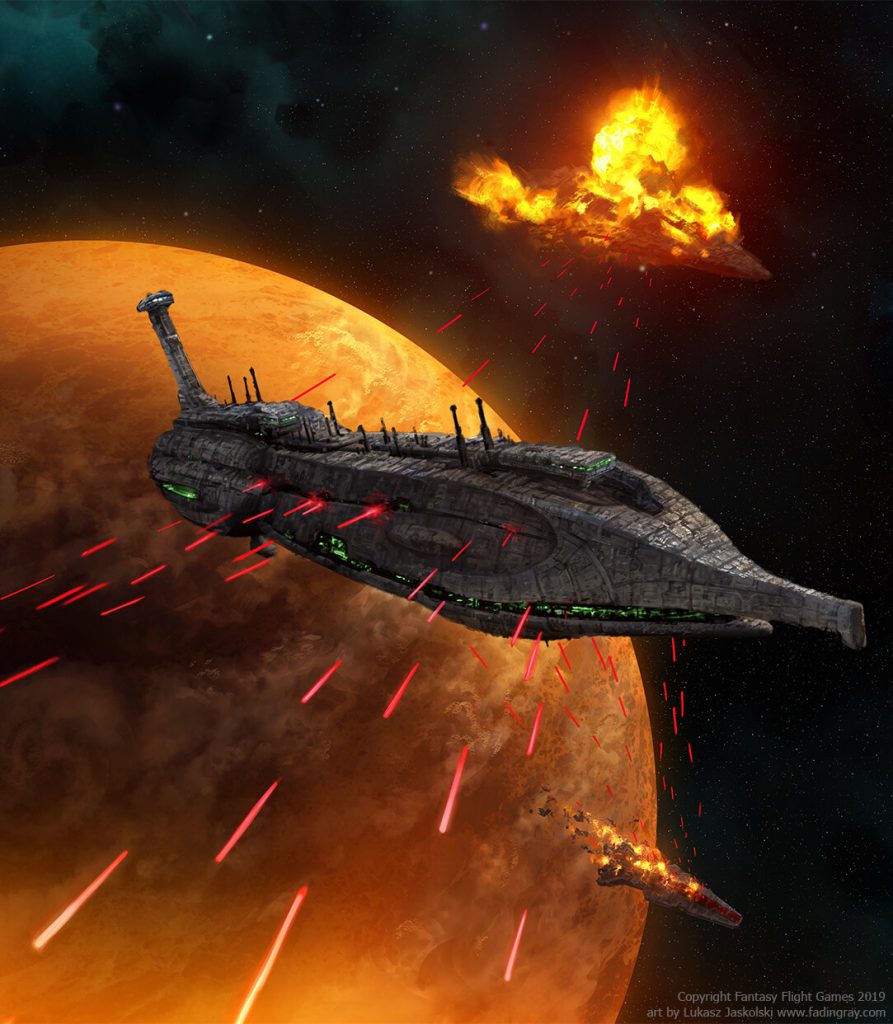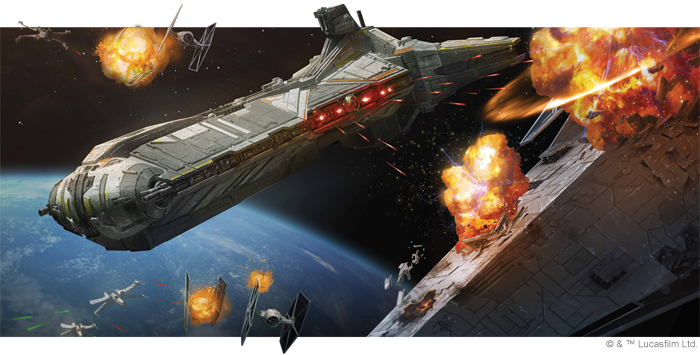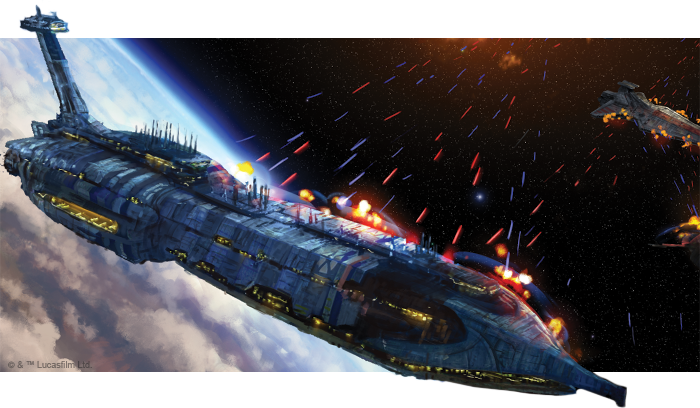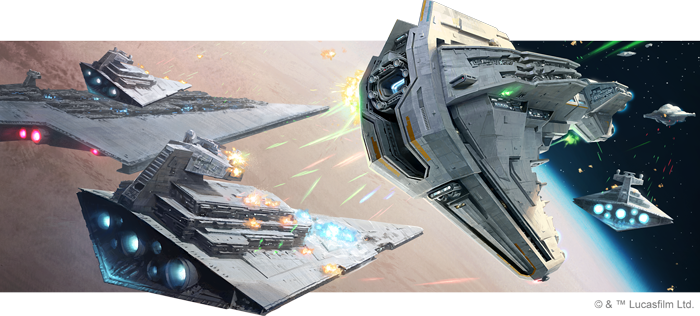This is Naval Academy, a new article series that discusses smart Armada play. I’ve introduced this lovely game and started working through the factions. Now, it’s time to get a perspective on gameplay. Today, it’s two of the game’s defence tokens and the surprising interplay they have.
The Last Line – “All batteries fire! Fire!”
Defence tokens are the primary means of mitigating damage. They’re found on all ships and aces, the latter defined as ‘unique squadrons who have defence tokens’. There are unique squadrons without defence tokens, but they’re not part of today’s story. All defence tokens exist to directly or indirectly keep your ships alive and management of this resource is crucial to survival. Defence tokens are normally spent during the aptly named Spend Defence Tokens step of attack resolution. Defence tokens start off readied (green) and become exhausted (red) when spent, or exhausted. An exhausted token can be readied again, either during the Status Phase, or by special abilities. An exhausted token can be spent again, but is discarded in the process. Defence tokens are a limited resource that can be spent conservatively for longevity, or spent often for higher impact. Optimal use of defence tokens is an exercise that evaluates the current threat against future threats against your unit. I might do a full article on defence token usage in general but for now, these two will suffice.

Salvo and Contain – “The wise Jedi avoids situations like this.”
Contain
Contain is one of the easiest defence tokens to understand. When spent, the attacker cannot resolve the standard critical effect (p. 2).
Caveats include:
- It prevents the resolution of the standard critical effect, but does not affect the damage that is associated with the critical icon because damage is pooled separately to critical effects. Critical effects are a bonus attached to a damage pool and exist independently of the total damage.
- Rolling a critical on a unit that can use it (usually a ship, or a bomber) essentially adds a critical effect of that colour to the pool as a resource that you can use to trigger critical effects.
- All ships have the standard critical effect (2), but there are a range of other ones obtained through upgrades. Contain doesn’t prevent the resolution of those effects.
- A unit may only resolve one critical effect per attack. Ships can increase this to two using Fire Control Teams.
The purpose of Contain is to prevent all of the nasty text effects on damage cards from hitting your ship when your opponent uses the standard critical effect. The effect is never resolved, and any damage taken is taken ‘face-down’, as a plain HP damage. In a best-case scenario, it can save you several shield points by preventing Projector Misaligned, or keep a ship alive by preventing Structural Damage. Contain kicks in when your ship is guaranteed to take damage from an attack, but it softens the blow.
Contain is pretty maligned and is widely considered the weakest defence token. There are two main reasons for this. Firstly, Contain does not predictably remove damage from the damage total like Brace, Evade, Scatter, or Redirect with abilities. Basically, all the other protective defence tokens can remove incoming damage outright. Even the offensively oriented Salvo indirectly preserves a unit’s HP, which I’ll describe below. When Contain does prevent damage, it does so unpredictably. The second issue is that Contain’s effect is limited to the standard critical effect and non-standard critical effects are very popular. The token can simply be bypassed by critical effect upgrades, and most ships fitted for combat will have one. As a result, a Contain token is usually considered a disadvantage because it occupies a defence token slot that could have been replaced with something better. Opportunity cost matters. The Rebel MC75 and Imperial Interdictor would both be much better ships if their spare Contain tokens were replaced with any other token.
‘Replacing Contain with something else’ is not a joke, either. The Contain token unironically gets a lot of value from being replaceable. Upgrades that replace a defence token, whether literally or in spirit are frequently used on Contain to squeeze utility out of it. This slightly unfortunate utility is exactly why I’m discussing Contain and Salvo together – because the most common replacement is Salvo.
Salvo
Salvo was introduced in 2019, approximately five years into Armada’s lifespan. It’s the newest defence token, and its release shook up how Armada players approach defence. Salvo’s rules are complex, but the short version is that spending it allows the defender to make an attack against the attacker using its printed rear battery armament. It essentially allows a defender to return fire against its attacker using a weaker-than-normal attack.
Caveats include:
- The Salvo attack is resolved with the same firing arcs and range as the original attack.
- Salvo attacks cannot benefit from the addition of any dice, and must use the dice printed on the ship card’s rear. There’s… one weird exception to this.
- Salvo attacks may only resolve the standard critical effect… with one weird exception.
- If the defender was destroyed by the attack, it can (and should) resolve the Salvo effect before it is removed.
- There’s a bunch of other caveats and stuff in the linked wiki page worth looking at. Salvo is a pretty involved and complex token, but it’s worth it.
Salvo was the first defence token that did not directly prevent damage. Its defensive utility stems from the threat of its use, which is expended once your ship is attacked. This is in contrast to other tokens that get defensive utility at the moment of their use. Salvo protects your ship by making it an undesirable target, especially for an attacker that is small or on very low HP. It’s widely considered an excellent token, especially since it benefits from powerful upgrades that enhance your salvo attacks. There are also three different ways to get access to Salvo if your ship doesn’t have one built-in: a Rebel commander and two generic upgrades. The combination of cards that provide and enhance Salvo open up the ability to build your ship to maximise Salvo attacks. Dubbed ‘salvo builds’, these ships derive much of their damage output from being attacked. They force a difficult decision out of their opponents, especially if they’re key to the game’s objective: attack and receive return fire, or leave a powerful enemy ship unmolested?
Ruthless Defence – “When I got to them, we went into aggressive negotiations.”
If you’ve read this far, you’ll know that Contain is considered a bit weak, Salvo is considered strong, and there are ways to get the Salvo effect out of another defence token. Ever since those cards were released, Contain is often found dead in a ditch in lieu of Salvo. Here’s how the two generic Salvo upgrades work.
Local Fire Control
Local Fire Control (commonly: LFC) is the simpler of the two. After deploying a ship that has this upgrade card, it must replace one of its defence tokens with a Salvo token. The most common victim is a Contain token, but sometimes it replaces a duplicate Redirect. Local Fire Control goes in the Weapons Team slot and it’s a fairly cheap way to get the utility of a Salvo token on a ship that is not using that slot for something more specialised.
Weapons Team slots are quite abundant across factions, so the loss of one isn’t always the worst. It only becomes a major problem if you want something more specific for the slot, or you don’t get adequate value out of your new Salvo. The real cost is the combination of replacing a token and paying points for it. If you’re replacing something more valuable than Contain, you should seriously consider how you intend to make up for the loss in defence.
Reactive Gunnery
Reactive Gunnery is a bit weirder, because it doesn’t replace a token directly. Instead, when defending, your ship may spend a readied (green) defence token and resolve the Salvo effect instead of the token’s regular effect. It replaces a defence token in spirit. The major upside to this is that any green defence tokens could become a Salvo at any moment, and you don’t have an actual Salvo that can be discarded through use or enemy shenanigans. The opponent must contend with not knowing whether you’ll return fire, and the possibility remains unless all of your tokens are exhausted (red) or gone.
There are some downsides to this. Firstly, it requires you to spend a readied defence token and since you can only spend one defence token of each type per attack, each use of Reactive Gunnery compromises your protection by preventing the use of that token type. The only situation in which Reactive Gunnery doesn’t weaken your overall defence is if the defence token you used to activate it was useless. Examples of this include spending a Redirect to trigger Salvo when you’re out of shields or spending a Contain to trigger Salvo when the standard critical effect is not a threat. The other downside to Reactive Gunnery is that it occupies the highly competitive Defensive Retrofit slot. Defensive Retrofits include some of Armada’s best upgrades with the singular purpose of keeping your ship alive. Since Salvo does not directly prevent damage and using it compromises your use of other defence tokens, fitting Reactive Gunnery incurs a sizable penalty to your survival.
Despite the drawbacks, Reactive Gunnery still gets taken often. It’s like a more intense version of Local Fire Control: you sacrifice more to opportunity costs and lost protection, but you also get an optional Salvo effect nested inside any readied defence token. Unsurprisingly, Contain is the most frequent target of Reactive Gunnery due to its low utility compared to others. Redirect is another target if your ship has no eligible hull zones to redirect to – many ships also have a duplicate Redirect to target.
Making some other dumb bastard die for his country
Enough theory. Here are some foundational salvo builds. Most of them only address the components necessary to make the ship capable of using Salvo. You can add other upgrades as necessary. You may notice that the Republic and Separatists have fewer salvo builds. That’s because both factions have a built-in Salvo on all of their medium and large ships. ‘Building’ a Republic or Separatist ship for Salvo is really just deciding whether Flak Guns and DBY-827s are worth it or not and sometimes, whether you want a duplicate Salvo from another source. There’s less finesse than the Galactic Civil War factions, which almost never have a native Salvo token.
Victory I-class Star Destroyer (Galactic Empire)
What: Local Fire Control, External Racks, Linked Turbolaser Towers, Harrow
Why: It’s 2022 and some of us are still trying to make the Victory good. Local Fire Control replaces one of your Redirects with a Salvo and the ship becomes quite prickly with two dice per Salvo attack at any range. Harrow is essentially mandatory for a Victory-class due to its incredible potency. Linked Turbolaser Towers are there for that precious red die reroll, which applies to your Salvo attacks too (you can’t add dice to a Salvo attack, but you can modify them). This gives you a Victory that is threatening to attack, and hard to shift.
You can add Admiral Ozzel (Officer) if you want a nudge of speed that synergises with Darth Vader (Officer). Engine Techs also goes really well with Harrow, but your ship becomes very expensive. External Racks are also a great contender for any Victory I intending to get into combat.
Interdictor Suppression Refit (Galactic Empire)
What: Minister Tua, Flak Guns, Reactive Gunnery, Interdictor
Why: The Interdictor has a strong rear battery of three dice and two Contain tokens that you can use with Reactive Gunnery. Minister Tua is mandatory for accessing Reactive Gunnery. This ship pairs oddly well with the Interdictor title because it can be used to refresh Reactive Gunnery for a second use. Flak Guns benefit both of your rear blue dice, giving you a three-die Salvo at long range. A salvo built Interdictor is one of the only viable combat builds for a ship that is designed for support and battlefield manipulation.
If you’re paying for the ship, you might as well use the unique Experimental Retrofit it comes with. Targeting Scrambler is a choice pick, seeing as you can use it when the bearer is attacked and your build depends on being shot often. Targeting Scrambler gives you a defensive boost, and lets you get value out of the Interdictor title when you aren’t refreshing the Reactive Gunnery. Grav Shift Reroute is another good one. Clever use of it can fundamentally change the way the game plays out by messing with the battlespace.
This build must balance using the Salvo and the Interdictor’s middling durability. You’re going to need that Engineering 5 to spit out lifesaving Repair commands, and may want additional sources of durability like Admiral Motti or Parts Resupply. Unlike sturdier ships that are comfortable in the thick of battle (MC80 Assault Cruiser, Venator), you need to manage your resources to stay alive. You’re not disengaging from combat with your terrible Speed 2, and the Flak Guns are there to give you extra reach to stay alive.
Venator II-class Star Destroyer (Galactic Empire)
What: Local Fire Control (Optional), Defensive Retrofit of Choice, External Racks, DBY-827 Heavy Turbolasers
Why: The Venator is hot, that’s why. It has a built-in Salvo, so taking Local Fire Control to replace the Contain is optional. External Racks are there for punching someone in the face (once), and the DBYs guarantee you Critical results or the infamous Hit + Critical on black dice. It lacks the ability to fit Flak Guns to be truly ferocious, but still has a place in the fleet. The Defensive Retrofit is mandatory because Salvo builds gain value as they survive, and a Venator is a big target.
Being an Imperial ship opens up some interesting possibilities, such as using Captain Needa on your Contain to get more survivability or Moff Jerjerrod to get extra manoeuvrability. If the ship is part of a Jerjerrod fleet, you might even attack often enough with black dice to justify Assault Concussion Missiles or Assault Proton Torpedoes. If you’re confident enough in your skills to use that kind of upgrade, Ordnance Experts become mandatory and you have an oversized Demolisher. Just be mindful of how much this ship hurts to lose.
Assault Frigate Mark II A (Rebel Alliance)
What: Local Fire Control or Reactive Gunnery or Kyrsta Agate, Linked Turbolaser Towers, Paragon (Optional)
Why: The Assault Frigate Mark II A was maligned for years because you paid a lot for a couple of extra battery dice, one of which was in the useless rear arc. Plus, it had less Squadron value. Salvo has elevated this ship from junk tier to the Rebel’s fighty medium. It’s got the necessary slots for either of the generic Salvo upgrades, or the Rebel-specific Kyrsta Agate. This ship is the smallest hull you’d reasonably consider for Agate, since she gets more value the larger her ship is. She also has the benefit of giving the ship a Salvo, rather than replacing a token with a Salvo (wholly or in spirit). Special mention goes to Paragon, which was a dumpster-tier title before Salvo arrived. Paragon’s black die does not specify a range, meaning it can be added to a pool regardless of attack range. You can’t add that black die to a Salvo attack, so you need to Salvo before your ship activates to meet the card’s activation criteria. Then, you add the black die to your standard attack during your later activation. It’s finicky and dependent on your opponent doing what you want, but it bears mention.
As for other slots, Linked Turbolaser Towers are there to address the unpredictable red dice. I’d also consider a defensive officer like Lando Calrissian or Walex Blissex over a potent Defensive Retrofit. Strong Defensive Retrofits like Early Warning System accumulate value over time, and a medium is less likely to survive that long. One-shot officers like Lando or Walex give you power at a lower price. Walex pairs exceptionally well with Kyrsta Agate and allows you to be almost reckless in how you spend defence tokens.
A note about Local Fire Control: equipping it forces you to change one of your defence tokens and all of the Assault Frigate’s tokens are considered ‘good’. There isn’t a no-brainer Contain to replace. The token you replace is chosen after the ship deploys, so you will know your opponent’s list and can tailor your decision to their list. If they have Ignition, you’re not giving up that Evade. Choose wisely, or use Reactive Gunnery/Kyrsta Agate to stay versatile.
MC80 Assault Cruiser (Rebel Alliance)
What: Kyrsta Agate or Reactive Gunnery, the kitchen Sink
Why: The MC80 has seen a resurgence thanks to Commander Agate. The infamously durable ship is now even tankier, and the option to improve its offensive output using a Defensive Retrofit adds versatility. Given its size, I would prioritise Kyrsta to get your token. Her secondary ability adds a mountain of staying power to the ship and then you go wild with fittings and upgrades. It doesn’t matter, as long as the build that emerges is an absolute pain to kill. That’s the true spirit of the MC80 Home One.
Top picks of mine include Walex Blissex if you’re using Kyrsta. He can retrieve your crucial Brace or Salvo from the grave and keep your ship going in terrifying fashion. You have two Defensive Retrofits, so your options are wide open. I default to Reinforced Blast Doors and Early Warning System for a more consistent, Kyrsta-focused build. If you can support it with Repair tokens, then Electronic Countermeasures might be a stronger pick to get incredible use out of your Brace in a meta that favours hard-hitting ships. Having two Defensive Retrofits is magnificent, and you can see why taking Reactive Gunnery in one of them can be a liability: it chews up one of your Defensive Retrofit slots and you’re limited to one Defensive Retrofit for actually protecting your ship. Use Kyrsta.
If you still have points left, then dice control is in order. The simple option is always Linked Turbolaser Towers. Leading Shots was nerfed, but it’s still a contender. You can even squeeze more durability out of your Ion Cannon slot using Point Defense Ion Cannons. If the ship isn’t overloaded enough, may I interest you in Engine Techs? There are a lot of options. Use your imagination and keep the crew’s life insurance paperwork in order.
Honourable Mention: Starhawk-class Battleship Mark I (Rebel Alliance)
What: Kyrsta Agate, any of the titles, the kitchen sink
Why: The Starhawk introduced Salvo to the Rebels. It’s a flying brick. Its purpose is two-fold: anchor your fleet and get into a boxing match with your opponent’s largest ship. The ship comes with a native Salvo and Kyrsta can add another non-Scatter token of your choice. Make your decision in response to the opponent’s fleet. If they’ve got Onagers, take an Evade. If they want to hammer you with a high-damage Kuat, get an extra Brace. All of the Starhawk’s titles give you an extra defence token. Amity is the cheapest at 6 points and gives you the all-round great Evade. Concord gives the extra Salvo, but it’s a monstrous 12 points due to its other rule designed to pair with Magnites. If you only want a bonus Salvo token, just take Kyrsta. Concord is only taken if you’re building specifically for Magnites.
You have the slot needed for DBY-827s and even Flak Guns, but neither Starhawk benefits much from Flak Guns because only one of their rear dice gets the bonus range. You’re probably better off with Flag Bridge and one shot of Intensify Firepower!. I’m running way over a reasonable word count here, so I won’t even elaborate on the ways you could build the rest of this ship. This article is about Salvo, anyway. The main rules of thumb are that Kyrsta was made for the Starhawk and taking her with a title bumps you up to an eye-watering six defence tokens. Tied for highest in the game. The Starhawk lacks a Defensive Retrofit slot and is a fleet centrepiece, so one of your Officer slots should have a defensive officer like Walex or Lando.
Venator I-class Star Destroyer (Republic)
What: Luminara Unduli, Local Fire Control, Flak Guns, DBY-827 Heavy Turbolasers, Intensify Firepower!, Tranquility, Officer of your choice
Why: You want to recreate the scene in Episode III where the Venator-class Gualara pulled up beside Grievous’ Invisible Hand and whacked it out of the sky. The build itself is predictable and fairly strict. You use Local Fire Control to replace your Contain with a second Salvo. You get maximum benefit out of Flak Guns and DBY-827s, turning your ship into a prickly hedgehog of death. Your faction is starved for dice control, so Intensify Firepower is mandatory, preferably if fed by a friendly source of Munitions Resupply or Clone Navigation Officer.
The build has a lot of moving parts, but is fairly intuitive. You have all the upgrades that benefit Salvo, and a double Salvo token to use it on. Luminara and Tranquility bring the finesse. They were made for each other and both trigger if you spend 0 or 1 defence tokens in response to an enemy attack. If you spend so few defence tokens, you can use Tranquility as a fake 2 point Redirect. Then Luminara kicks in and readies a defence token on her ship, or any other friendly ship at range. You can only use it to ready a defence token that wasn’t spent during that attack, so generally, players spend heavily during the first attack and spend conservatively later to benefit from this magical power. The goal here is to get into a cycle of using Salvo attacks made during enemy attacks to flip your other Salvo token, giving you an engine of death lasting as long as your HP. You can also use it more defensively by triggering Luminara to refresh an ally’s tokens and keep them alive for longer. The Scatter on one of your aces, or a crucial Brace are prime targets.
Officer choice is up to you. Clone Captain Silver gives you GTFO potential when your luck runs out, and Barriss adds some more Redirect-y nonsense, but is expensive. Generic officers are also worth considering.
Providence-class Carrier (Separatists)
What: Reactive Gunnery (optional), Linked Turbolaser Towers, Intensify Firepower!, Lucid Voice, Defensive Retrofit and Officer to taste
Why: It doesn’t make sense, but the carrier type Providence is a better battleship. Roll with it. Lucid Voice is nice for removing the need for Flak Guns and DBY-827s, and opening up your Turbolaser slot for dice control. An optional Reactive Gunnery lets you fish value out of the Contain when it’s not being used, and Intensify Firepower adds another layer of dice control for very consistent damage output. The downside is that this ship has limited synergy with Separatist commanders. There are Separatist commanders who add dice to attacks, which do nothing for Salvo. Others want very specific builds. Your best pairing is probably General Grievous, who lets you spend tokens more aggressively as you take losses. It doesn’t easily slot into a lot of Separatist fleets. What it does have is consistency, though. Two sources of dice control and the longest possible Salvo attack range is a great way to keep the pain rolling, especially since your opponent will often be compelled to fire on a ship of Lucid Voice’s size out of necessity.
For Officers, it’s good to feed the ship Concentrate Fire tokens. Maybe Rune Haako, if you manage to decipher his rules. Since Lucid Voice replaces a blue die with a black die on the sides, Assault Proton Torpedoes becomes a viable. In that case, I’d include Shu Mai. She gives you two rounds of crucial dice control, but you have to predict which two rounds you’ll need them. On a large ship, two rounds of black dice usage is pretty good value. Sprinkle in a Defensive Retrofit of your choice.

Conclusion – “Because, Hobbie, we rely on pluck, courage, and skill instead of capital expenditure.”
I hope you learned something about the value of the Salvo and Contain tokens from this very, very long article. This is also the first time I’m doing a more in-depth builds section, which was really fun. If you’re ever out to make a salvo build, you’re basically playing a balancing game of costs and benefit. As a rule, you’ll want ships with fat rear batteries (preferably three dice), and slots that let you procure a Salvo token and support Salvo attacks. It’s pretty intuitive once you get used to it.
To the three fans of Contain out there, I’m sorry this turned into an article about why Contain is bad. That’s kinda just the way things are, but take heart. There’s so much value in being a target for hassle-free replacement. I’ve never winced when replacing Contain with something better, and peace of mind has its own value. Here’s to Salvo, Armada’s most lethal defence token and here’s to Contain, the best seat-warmer defence token there ever was.
Have any questions or feedback? Drop us a note in the comments below or email us at contact@goonhammer.com.






